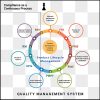In July 2023, the European Parliament granted an extension to the new European Union Medical Device Regulation (EU MDR). This extension acknowledges the challenges that have arisen due to slow market readiness and lack of notified bodies, and grants companies additional flexibility to meet the demand for safe, innovative and high-performance medical devices and new therapies.
How EU MDR Impacts Device Labeling
EU MDR was enacted to revamp the existing legal framework governing medical devices, replacing the previous Medical Device Directive (MDD) introduced in the 1990s. It aims to move the industry towards a more patient-centered approach to regulation, and will enhance patient and user safety. EU MDR involves the recertification of certain categories of medical devices, including implants, prosthetics, blood glucose meters and catheters, under stricter safety criteria. Originally scheduled to take effect in May 2021, the deadline for compliance has been extended to 2027 or 2028 depending on the risk class of the device.
Rather than redirecting budgets away from compliance preparations, medical device manufacturers should seize this opportunity to get ready for the new deadline. Complying with EU MDR requires significant operational reforms, especially in regard to the labeling process.
Manufacturers often have hundreds or thousands of Stock Keeping Units (SKUs), each requiring compliant labels. EU MDR mandates that each label include standard iconography and instructions for accessing Electronic Instructions for Use (eIFUs). The regulation also requires Unique Device Identification (UDI), consisting of the UDI-DI (device identifier) and the UDI-PI (product identifier). UDI-PIs contain dynamic information such as lot/batch numbers and expiry dates, which change often.
Manufacturers must ensure that identifiers are correctly applied to products, and that key data elements and formats are accurate. In addition, manufacturers need to have access to centralized data, audit tracking, robust security controls, eSignature capabilities and strong workflow management to ensure compliance. This requires dynamic and data-driven labeling that can only be achieved with the use of an end-to-end validated labeling solution.
Noncompliance with labeling criteria outlined in EUDAMED (European Database on Medical Devices) could result in regulatory enforcement, costly product recalls, fines, shipment retention at borders and loss of partnerships. These operational consequences, while severe, are essential for ensuring a safe market, leaving companies with no alternative but to comply.
Compliance is Possible
Compliance with EU MDR’s new labeling requirements is no easy feat. Spreadsheets, error-prone legacy systems and even some software packages are likely to struggle to keep pace with the complexity required for compliance, efficiency, validation, brand consistency, responsiveness, customer satisfaction and revenue. However, the recent EU MDR extension offers a valuable opportunity. It reassures patient communities of regulators’ commitment to safety and allows medical device manufacturers to evaluate their existing labeling practices. Adopting dynamic data-driven labeling that integrates with trusted sources provides an automated and validated solution that can help ease this added regulatory burden.






